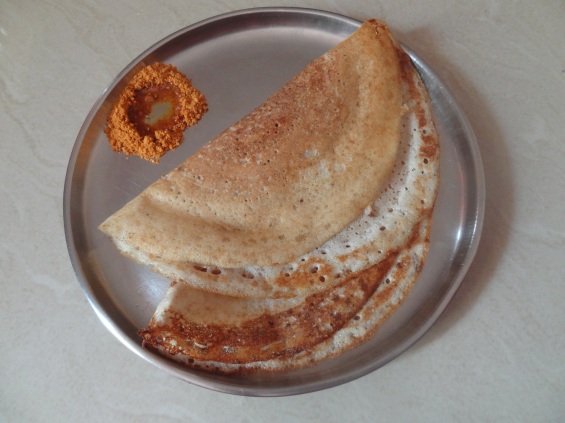I’m new to cooking with millets. I know there is a lot of talk, these days, about how millets are extremely good for us health-wise and environment-wise, and how we should be cooking a lot more with them. I haven’t really used millets much, though. At the most, I have used just two varieties of millet – ragi aka finger millet and bajri aka pearl millet – and that too in just a couple of dishes. I understand there’s a whole millet world out there to explore – a whole lot of varieties of millet, a whole lot of things that I could do with them.
I recently had the opportunity to attend a talk by Mr. Jayaram HR, owner of The Green Path, a restaurant that serves a variety of foods made from millets, as well as some ‘forgotten foods’. He has an interesting life story, but that is for another day. His talk on how it is high time millets found more of a foothold in our lives acted as a catalyst for me – it inspired me to do more with them in my kitchen.
And then, close on the heels of this talk, the hugely successful Organics And Millets Mela was held at the Palace Grounds, which I managed to attend. The scale of the event, the effort made by the government to reach out to the commonest of people, and the sheer variety of millet-based dishes on display stunned me. The mela gave further shape to my dreams of cooking with millets. Campaigns by fellow food bloggers for the mela gave rise to the sharing of a huge number of millet dishes, wowing not just me but a whole lot of people.
To cut a long story short, all of this has ensured that I have, finally, jumped up on the millets bandwagon too. I have started cooking with other types of millets too – other than the two varieties I was used to. It’s too early to say whether this has had an good impact on my health or not, but I have started using them for sure, slowly and steadily. I will update you all about my millet journey, as and when I reach significant milestones.
For now, here’s presenting to you a tried and tested recipe for Barnyard Millet (‘Kudhiravaali‘ in Tamil) dosa, which all of us in our family love. These dosas contain absolutely no rice, and taste just like the regular ones – no one can tell the difference! They are supposed to be more filling, yet lighter on the digestive system, than the rice-based dosas.

Here is how I make these barnyard millet dosas.
Ingredients (makes 15-18 dosas):
- 2 cups of barnyard millet aka kudhiravaali
- 3/4 cup whole white urad
- 1/4 cup sago pearls (sabudana)
- 1 teaspoon fenugreek seeds (methi)
- Salt, to taste
- Oil, as required to make the dosas
Method:
- Wash the barnyard millet 2-3 times in running water, or till the water runs clear. Soak it overnight in just enough water to cover it.
- Wash the urad thoroughly. Soak it, along with the fenugreek seeds, overnight in enough water to completely cover them.
- Soak the sago pearls overnight, in just enough water to cover them.
- In the morning, drain out the excess water from the urad and fenugreek seeds, and grind them to a fine paste in the mixer. Remove into a large vessel.
- Now, drain out the excess water from the barnyard millet and sago pearls, and grind them together to a fine paste in a mixer. Transfer to the vessel that contains the urad batter. Mix well.
- Add salt to taste to the batter.
- Keep the batter, covered, in a cool and dry place in the kitchen for about 8 hours, to ferment. Fermenting time might be less than 8 hours in case of hot summer days.
- Once the batter has fermented and risen sufficiently, keep the vessel, covered, in the refrigerate.
- Get the batter out of the refrigerator only when you are ready to make dosas.
- Heat a dosa pan till drops of water dance on it, and then reduce the flame. Spread out a ladleful of the batter in the centre of the pan. Spread about 1 teaspoon of oil around the periphery of the dosa. Cook for a couple of minutes, and then flip the dosa over to the other side. Let cook for a couple of minutes more. Transfer the dosa to a serving plate.
- Prepare all the dosas in a similar fashion. Serve hot with sambar or chutney of your choice.
Notes:
- You can substitute barnyard millet with any other type of millet, to make these dosas.
- Beaten rice aka poha can be used instead of sago pearls, in the same quantity.
- There is no need to add additional water while grinding the urad, sago, fenugreek and barnyard millet. If you feel you aren’t able to grind the batter well, add a little water.
- Do not keep the batter at room temperature for too long, after fermentation occurs. This will increase the chances of the batter turning sour.
- There is absolutely no difference in the proceedure of making these dosas, vis-a-vis regular rice-based dosas.
You like? I hope you will try out these dosas too, and that you will love them just as much as we did!
********************
Interested in reading about the other millet recipes on my blog? Here you go!
8 thoughts on “Barnyard Millet Dosa| No-Rice Dosa Recipe”